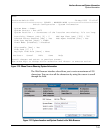
Configuring IP Addressing
Overview
Overview
You can configure IP addressing through all of the switch’s interfaces. You can
also:
■ Easily edit a switch configuration file to allow downloading the file to
multiple switches without overwriting each switch’s unique gateway and
VLAN 1 IP addressing.
■ Assign up to 8 IP addresses to a VLAN (multinetting).
Why Configure IP Addressing? In its factory default configuration, the
switch operates as a multiport learning bridge with network connectivity
provided by the ports on the switch. However, to enable specific management
access and control through your network, you will need IP addressing. Table
8-1 on page 8-11 shows the switch features that depend on IP addressing to
operate.
IP Configuration
IP Configuration Features
Feature Default Menu CLI Web
IP Address and Subnet Mask DHCP/Bootp page 8-5 page 8-6 page 8-10
Multiple IP Addresses on a VLAN n/a — page 8-8 —
Default Gateway Address none page 8-5 page 8-6 page 8-10
Packet Time-To-Live (TTL) 64 seconds page 8-5 page 8-6 —
Time Server (Timep) DHCP page 8-5 page 8-6 —
IP Address and Subnet Mask. Configuring the switch with an IP address
expands your ability to manage the switch and use its features. By default, the
switch is configured to automatically receive IP addressing on the default
VLAN from a DHCP/Bootp server that has been configured correctly with
information to support the switch. (Refer to “DHCP/Bootp Operation” on page
8-12 for information on setting up automatic configuration from a server.)
However, if you are not using a DHCP/Bootp server to configure IP addressing,
8-2


















